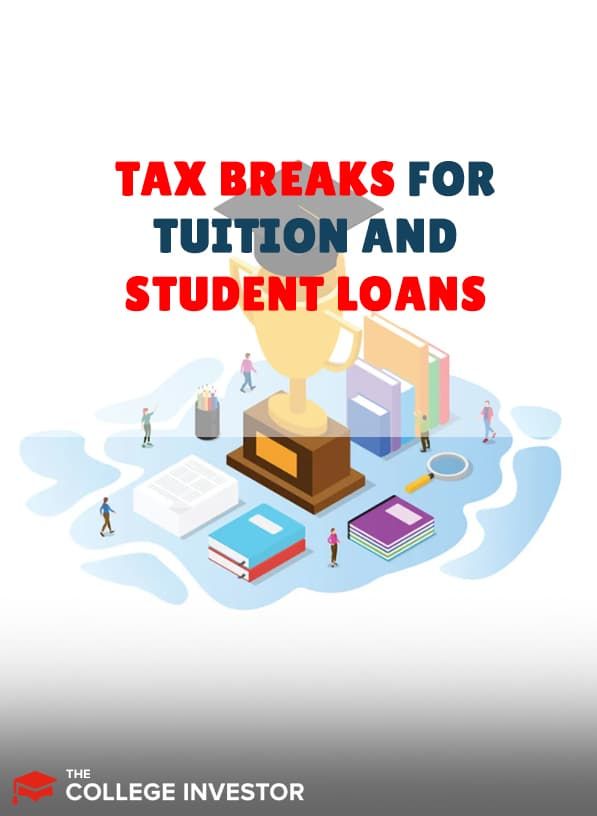
You've probably heard of the student loan interest deduction. But what you may not know is that this is just one of several tax breaks for tuition and student loans that are baked into the U.S. tax code.
There are also federal income tax advantages for saving for college through 529 college savings plans, Coverdell Education Savings Accounts, and the Education Savings Bond Program. And some states provide state income tax deductions or tax credits based on contributions to 529 plans.
Going to college is getting more expensive every year. But by taking advantage of as many tax breaks for tuition and student loans as you can, you can effectively reduce the overall cost of your post-secondary education. Here are the credits and deductions that you should be aware of.
American Opportunity Tax Credit
The American Opportunity Tax Credit (AOTC) provides a partially-refundable tax credit based on amounts spent on college tuition, fees and course materials. Course materials include required textbooks, supplies and equipment.
The AOTC is worth up to $2,500 per student, representing 100% of the first $2,000 in qualified expenses and 25% of the second $2,000. The AOTC is partially refundable, up to $1,000 (40%), and is not subject to the Alternative Minimum Tax (AMT).
Taxpayers can claim the AOTC for up to four years of post-secondary education and, at most, four tax years per student. And it can be claimed for expenses paid during the first three months of the next tax year in addition to the current tax year.
To qualify for the AOTC, the student must be enrolled on at least a half-time basis in a college or university that is eligible for Title IV federal student aid. And the student must be pursuing a college degree or certificate.
The AOTC phases out at $80,000 to $90,000 for single taxpayers and $160,000 to $180,000 for married taxpayers who file a joint return. Taxpayers who file tax returns as married filing separately aren't eligible.
Lifetime Learning Tax Credit
The Lifetime Learning Tax Credit (LLTC) provides a non-refundable tax credit worth up to $2,000 per taxpayer, based on 20% of the first $10,000 in tuition, fees and required textbooks, supplies and equipment. Note that the tax credit is per taxpayer and not per student.
The LLTC is more flexible than the AOTC in multiple ways. For one, it can be claimed for an unlimited number of years. The student is also not required to be degree-seeking, so the LLTC can be used for continuing education.
It phases out with a modified adjusted gross income (MAGI) of $80,000 to $90,000 for single filers and $160,000 to $180,000 for filers who are married filing jointly.
Qualified Scholarships
Scholarships that are used to pay for tuition, fees and course-related materials (e.g., books, supplies and equipment) are tax-free if the student is degree-seeking and the scholarship is not provided as a fee for services.
Amounts used to pay for living expenses, such as transportation and room and board, are taxable however. The student must report the taxable portion of their scholarships on their federal income tax return.
Qualified scholarships are also exempt from FICA taxes. There's also no income phaseout on the exclusion from income for qualified scholarships which can make it one of the most valuable benefits on this list of tax breaks for tuition and student loans.
Employer-Paid Educational Assistance
Up to $5,250 in employer-paid educational assistance may be excluded from a taxpayer’s income. Qualified expenses include tuition, fees, books, supplies and equipment, as well as student loan repayment.
The student doesn't need to be degree-seeking to claim this benefit. Eligible courses can include undergraduate, graduate and continuing education courses, as well as employer-provided courses. The courses must be taken by the employee, not the employee’s spouse or dependents.
While there is no income phaseout, employer-paid educational assistance may not discriminate in favor of highly-compensated employees. There is also a cap on the amount of assistance that may be provided to owners or shareholders who own more than 5% of the business.
Student Loan Interest Deduction
The Student Loan Interest Deduction is an above-the-line exclusion from income for up to $2,500 in interest paid on all federal and most private student loans. It can be claimed even if the taxpayer does not itemize deductions on their federal income tax return.
The Student Loan Interest Deduction phases out at $70,000 to $85,000 for single taxpayers and $145,000 to $175,000 for married taxpayers who file a joint return. Taxpayers who file tax returns as married filing separately are ineligible. These income phaseouts are for 2022 and are adjusted annually for inflation.
Tuition Gift Tax Exclusion
Under section 2503(e) of the Internal Revenue Code of 1986, tuition paid directly to an educational institution is exempt from gift taxes. This tax break is limited to tuition only. Other college costs, such as fees, room and board, and transportation, are not eligible.
This benefit is rarely needed, since the annual gift tax exclusion is usually sufficient. The annual gift tax exclusion is $16,000 per giver per recipient in 2022. So a married couple could give up to $32,000 annually to each grandchild to cover college costs (or for any other purpose). Contributions can be made up to five times the annual gift tax exclusion amount using a 529 plan through five-year gift-tax averaging.
There is no income phaseout on the tuition gift tax exclusion. But some colleges may treat such gifts as a resource, which reduces eligibility for need-based financial aid on a dollar-for-dollar basis.
College Savings Plans
Contributions to college savings plans, such as 529 plans, prepaid tuition plans and Coverdell Education Savings Accounts, are made with after-tax dollars. Earnings accumulate on a tax-deferred basis and are entirely tax-free when used to pay for qualified higher education expenses.
Qualified higher education expenses include tuition, fees, books, supplies, equipment and special needs expenses. Room and board is a qualified expense if the student is enrolled on at least a half-time basis. Transportation is not a qualified expense.
529 Plans
Up to $10,000 in student loan repayment is considered a qualified expense for 529 plans. This is a lifetime limit for the borrowers. The beneficiary and the beneficiary’s siblings are each eligible for up to $10,000 in student loan repayment.
About two-thirds of the states also provide a state income tax deduction or tax credit based on contributions to the state’s 529 plan. Seven of these states provide it for contributions to any state’s 529 plan. All but four of the states provide the state income tax break even if the taxpayer takes a distribution on the next day. The four states base the state income tax break on contributions net of distributions.
There are no annual contribution limits on 529 plans other than gift tax exclusion limits. However, 529 plans allow five-year gift tax exclusions, also known as "superfunding," which allows lump sum contributions greater than the annual gift-tax exclusion to be treated as occurring over a five-year period. Each state has its own aggregate contribution limit, which range from $235,000 to $542,000. There are no income phaseouts on 529 plans.
See our full 529 plan guide and find your state to see what your state offers.
Coverdell Education Savings Accounts
Contributions to Coverdell Education Savings Accounts (ESAs) are limited to $2,000 per year from all sources through age 18. There are income phaseouts that range from $95,000 to $100,000 for single filers and $190,000 to $220,000 for married filing jointly. These phaseouts aren't adjusted for inflation.
Savings Bonds
There is an exclusion from income for interest on Series EE U.S. savings bonds issues in 1990 and subsequent years, and on all Series I U.S. Savings bonds, if the bond is used to pay for tuition and fees. The income exclusion also applies to rollovers into a 529 plan, prepaid tuition plan or Coverdell Education Savings Account.
There's an income phaseout from $85,800 to $100,800 (single) and $128,650 to $158,650 (married filing jointly). Married filing separately is ineligible. These income phaseouts are for 2022 and are adjusted annually for inflation.
Student Loan Forgiveness
Student loan forgiveness and discharges are tax-free through December 31, 2025. And there's a strong chance that this exclusion from income could be extended or made permanent.
Even if this overarching benefit goes away, Public Service Loan Forgiveness and a variety of other programs would remain tax-free. However, other types of loan cancellation, such as death and disability discharges and the forgiveness that occurs after completing an income-driven repayment plan, would once again become taxable.
Final Thoughts
It's important to understand that the IRS doesn't allow "double-dipping." Coordination restrictions prevent taxpayers from claiming two tax breaks for tuition and student loans based on the same qualified expenses. Each dollar of qualified expenses can be used to claim only one tax break.
The American Opportunity Tax Credit pays more per dollar of qualified expenses than the Lifetime Learning Tax Credit, Qualified Scholarships and 529 plan distributions. So if a taxpayer is eligible for both the AOTC and the LLTC, they should choose the AOTC as it's more valuable.
Taxpayers should carve out $4,000 in tuition and textbook expenses to qualify for the maximum American Opportunity Tax Credit. For example, they could treat all or part of a scholarship as taxable in order to maximize their qualified expenses for the AOTC.
For additional information about tax breaks for tuition and student loans, see IRS Publication 970 - Tax Benefits for Education. Publication 920 is typically updated each year in January or February.

Mark Kantrowitz is an expert on student financial aid, scholarships, 529 plans, and student loans. He has been quoted in more than 10,000 newspaper and magazine articles about college admissions and financial aid. Mark has written for the New York Times, Wall Street Journal, Washington Post, Reuters, USA Today, MarketWatch, Money Magazine, Forbes, Newsweek, and Time. You can find his work on Student Aid Policy here.
Mark is the author of five bestselling books about scholarships and financial aid and holds seven patents. Mark serves on the editorial board of the Journal of Student Financial Aid, the editorial advisory board of Bottom Line/Personal, and is a member of the board of trustees of the Center for Excellence in Education. He previously served as a member of the board of directors of the National Scholarship Providers Association. Mark has two Bachelor’s degrees in mathematics and philosophy from the Massachusetts Institute of Technology (MIT) and a Master’s degree in computer science from Carnegie Mellon University (CMU).
Editor: Robert Farrington Reviewed by: Chris Muller
